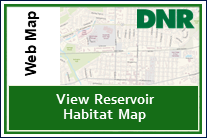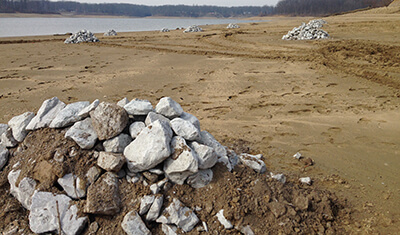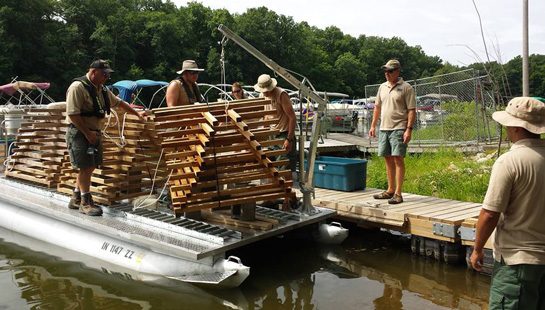
The Reservoir Habitat Enhancement Program, which started in 2016, improves and enhances habitat through the placement of structures, shoreline stabilization, and dredging.
In some reservoirs, existing aquatic habitat has deteriorated. Other reservoirs may have been lacking in habitat since their construction due to water quality, water level fluctuations, or other issues.
Projects
Since 2016, more than 10 different habitat-enhancement projects have been conducted across Indiana. This interactive map provides locations, habitat structure type, and date of installation for DNR habitat-enhancement projects. Every attempt has been made to provide accurate information about structure placement; however, due to a wide range of factors, the content accuracy or completeness of this product is not guaranteed and is therefore intended for reference purposes only.
You can download the GPX files to import the habitat waypoints into a depth finder or GPS unit. Each brand and model of depth finder will have different methods for importing these files. There are resources available on YouTube and online for importing GPX files, and you may have to consult your owner’s manual for details. There are also online resources for converting GPX files to other formats.
Files are compressed in .zip archive.
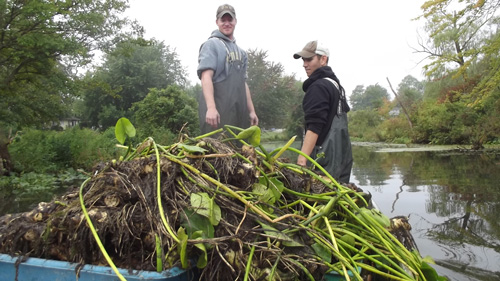
- Cecil M Harden Lake (Raccoon State Recreation Area)
- J.C. Murphey Lake
- Lake Sullivan
- Mississinewa and Salamonie Lakes
- Monroe Lake
- Patoka Lake
Reservoir habitat program steps
- Use sonar to map reservoir water depths (bathymetry) and vegetation to determine amount of available habitat.
- Rank reservoirs based on habitat availability.
- Select one to two reservoirs each year as project lakes.
- Work with agencies and partners to develop a Habitat Enhancement Plan for the project lake.
- Obtain required state and federal permits.
- Use techniques to improve fish habitat through placement of artificial structures, vegetation planting, shoreline stabilization, or dredging.
Some commonly used structures
- Rock Piles
Purpose
- Provide feeding habitat for aquatic insects, crustaceans, and bait fish.
- Attract fish to forage for food or reproduction.
Construction
- Rock or concrete piles between 1 and 3 cubic yards (less than 2.5 tons).
- Typically 20 1-ton humps per acre.
- Trees
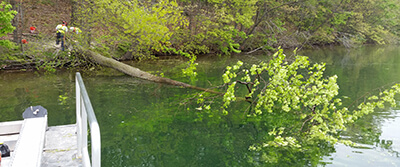
Purpose
- Attract fish for reproduction, food, and cover in shallow areas.
Construction
- Hinge cut large, spreading complex branches.
- Trees that naturally fall into the lake.
- Brush Piles, Log Piles, Christmas Trees, Stumps
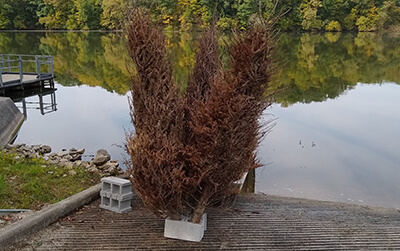
Purpose
- Provide protection from predators in shallow water.
- Hardwood and cedar piles may help attract black bass, crappies, and juvenile sunfish.
Construction
- Cluster of trees secured with concrete block.
- Hardwoods like oaks last longer, but are more likely to snag lures.
- Small fish prefer dense cover such as cedar, while large fish tend to congregate around less-dense trees like oaks
- Pallet Structures
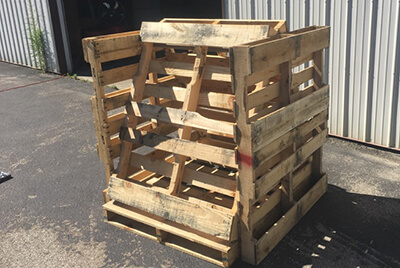
Purpose
- Provide cover for fish in deep water.
Construction
- Five standard-size pallets joined with deck screws.
- Anchored with concrete blocks inside the structure.
- Density is approximately 20 per acre.
- Pennsylvania Porcupine Cribs
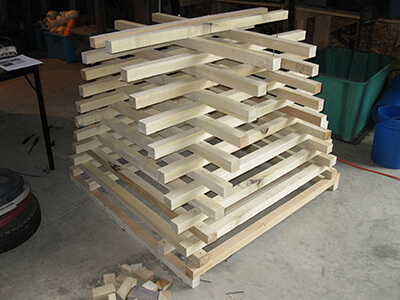
Purpose
- Provide cover for fish in deep or shallow water.
Construction
- Made of rough-cut green (fresh cut) hemlock or popular stacked in a pyramid shape.
- Can be made tall (about 4 feet or short about 3 feet depending on depth of placement.
- Anchored with concrete blocks inside the structure.
- Density is approximately 20 per acre.
- Hoosier Cubes
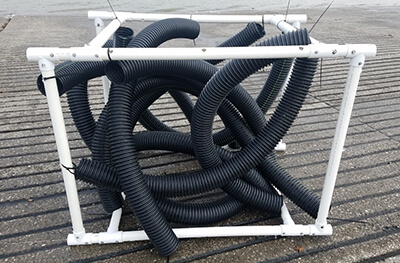
Purpose
- Structure collects periphyton, which is a mix of algae, fungi, and bacteria that is appealing to insects and fish.
Construction
- Generally cubes are made of PVC and 3 feet tall, 4 feet wide, and 4 feet deep.
- Sections of 4-inch diameter corrugated drain pipe are attached to cube with zip ties.
- Density is 20 cubes per acre.
- Note: When building Hoosier cubes, PVC rated for drinking water and HDPE-rated corrugated drainage tile are used. These are not known to leach into the water and therefore are unlikely to be detrimental to the environment.
- Stake Beds
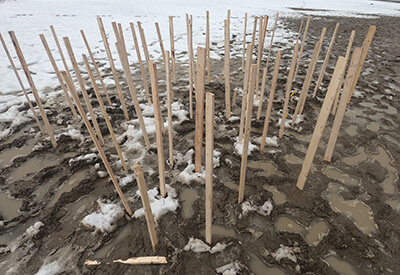
Purpose
- Provide a simple local habitat for aquatic invertebrates that many fish eat.
- Mimic natural brush/vegetation clumps fish prefer for cover.
Construction
- Agricultural fence posts or smaller stakes driven into the lake bottom.
- Placed in 3–4 foot depths at slight angles to the water surface.
- Pennsylvania Bass Nesting Platforms (Bass Platforms)
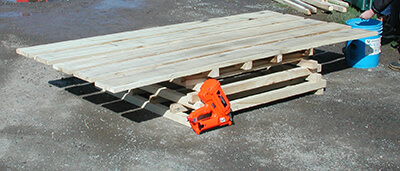
Purpose
- Provides reproduction, nesting, and nursery habitat for largemouth bass.
- Provides shallow-water (less than 10 feet) cover for largemouth bass.
Construction
- Wide plank green (fresh cut) hemlock or poplar laid on top of a short board pyramid.
- Anchor with eight concrete blocks.
- Five to 10 nesting structures at one site in alternating rows at depths of 5–10 fee
- Typical density is 10 structures per acre.
- Aquatic Plant Establishment
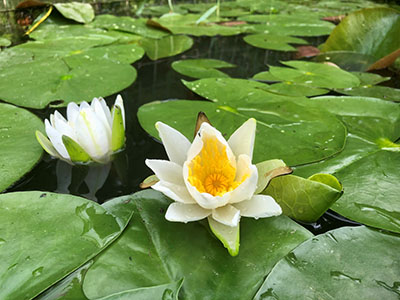

Purpose
- Produce and consume oxygen.
- Stabilize temperature and light.
- Recycle nutrients.
- Control turbidity.
- Provide food, spawning substrate, and habitat for invertebrates and fish.
Construction
- Purchase native plants from commercial growers to ensure correct genetic stock and reduce introduction of invasive plants.
- Choose planting locations protected from wave action and soft substrate.
- Select locations with gradual sloping bottom and plant vegetation at varying depths to account for water level fluctuations.
- Protect plantings from herbivores (e.g., deer, turtles, geese, fishes) by placing a fence around them.
For more information about reservoir habitat best management practices, visit the National Reservoir Habitat Partnership.
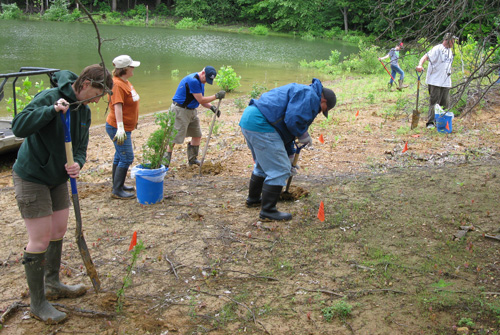
Contact
Sandy Clark-Kolaks, south region fisheries research biologist
Email: sclark-kolaks@dnr.IN.gov
Phone: 812-287-8300

